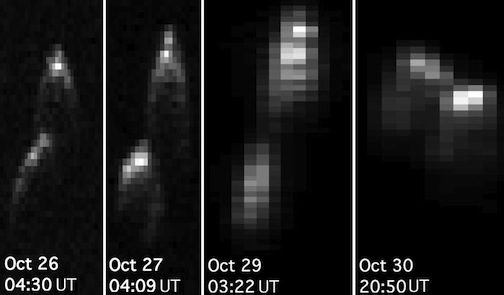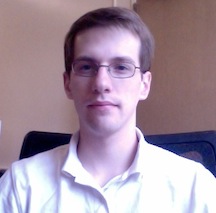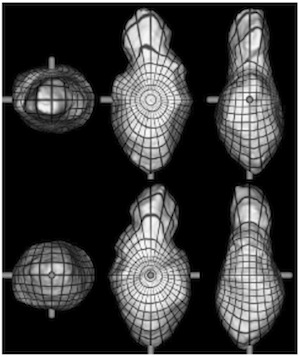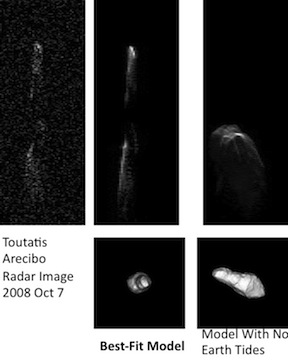I'm an NRAO Jansky Fellow, currenty working at the Department of Earth and Space Sciences, in Jean-Luc Margot's group. From 2005 to 2010, I was a graduate student in planetary science at Caltech. As a planetary radio & radar astronomer, I use the techniques of radio astronomy to study objects in the solar system, particularly near-Earth asteroids. Here are a couple of my current projects:
Contact Binary Asteroids
--updated 2011 Sep 8--

|
| Delay-Doppler radar images of the contact binary 2003 UV11, obtained with the Arecibo Planetary Radar in October 2010. Within each image, distance from Earth increases from top to bottom and line-of-sight velocity from left to right. UV11 is ~400 m in length and made of two roughly equally-sized components. |
Based on radar imaging, about 9% of near-Earth asteroids are contact binaries: composed of two approximately round (sometimes very approximately round) pieces resting on each other. Since another fraction, about ~15%, of near-Earth asteroids are separated binaries, with the components in mutual orbit, the contact binaries were most likely separated at some point in the past and later recombined, under the influence of radiation pressure (the BYORP effect), or three-body gravitational interactions with the Sun.
We have considerable information on the shapes and spin states of a few contact binaries - Castalia, Mithra, Itokawa, Toutatis, and perhaps three more. I'm currently reviewing the data available for other contact binaries, to understand what we can learn from the population as a whole and if their properties preserve any details of their formation.
4179 Toutatis
--updated 2011 Sep 8--
|
The near-Earth asteroid Toutatis is near to, but not quite in, a 4:1 orbital resonance with Earth. It makes close approaches to us every four years for a couple of decades, then does not come close for between fifty and sixty years. Toutatis was discovered in 1934, lost until just after its 1998 flyby, and recovered and named by Christian Pollas. In 1992 and 1996, my thesis advisor Steve Ostro and Scott Hudson led extensive radar imaging campaigns and showed that Toutatis is elongated, bifurcated, and in a slowly tumbling non-principal-axis (NPA) rotation state. Because of its elongated shape and slow rotation, Toutatis's rotation is significantly perturbed each time it flies by Earth. The planet's tides can change Toutatis' rotation rate by up to a tenth of a degree per day. That may not seem like much, and it is only a thousandth of Toutatis' total spin, but it is very easy to detect with images from multiple flybys. Working with Jean-Luc, Lance Benner at JPL, and Dan Scheeres and Yu Takahashi at CU Boulder, I am studying all of the available Toutatis images, from 1992, 1996, 2000, 2004, and 2008, to understand exactly how Toutatis' spin has changed and to predict what we will see when we observe Toutatis next year (the 2012 flyby will be the last opportunity to observe Toutatis from the ground until 2069). The most exciting part of studying the Toutatis' rotation is that it tells us about Toutatis' internal structure. The spin of an NPA rotator is determined in part by its moments of inertia - how mass is distributed inside the object. We have shown that Toutatis' moments of inertia are not consistent with uniform density. The most plausible model of the asteroid's interior is two cores, one in each lobe, surrounded by lower-density fill, as we would expect if Toutatis was a separated binary system in the past and the two components slowly combined to give us the current shape. |
Contact:
Dept. of Earth and Space Sciences
University of California, Los Angeles
595 Charles Young Drive East
Los Angeles, CA 90095
E-mail: mbusch@ess.ucla.edu
In case anyone wants to read it, my CV is available here.


